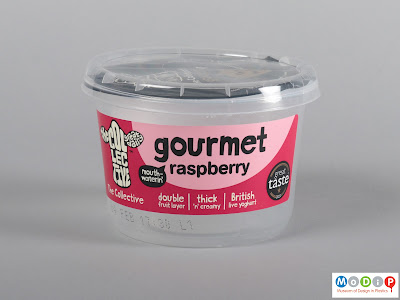One of the cases in our current
exhibition, Reuse, looks at the problems that black plastics have when it comes
to the recycling system and therefore how the material is then reused.
When
products and packaging made of plastics enter the recycling system, they need
to be separated into individual materials, for example PET, HDPE, or PP, so
that they can become useful recyclate. In automated systems, this is done using
a Near Infrared (NIR) Identification system. A beam of light is shone at the
material and interacts with the chemical compounds of the waste; the light will
either be absorbed or reflected across a spectrum of wavelengths providing a
signature for the material. Black plastic products are not able to be sorted
using the NIR device because the carbon black pigments absorb all of the light,
making it impossible to see the signature of the material. As such black
plastic packaging is often rejected for recycling.
Voet, V.,
Jager, J., Folkersma, R., 2021. Plastics in the Circular Economy, De Gruyter
graduate. De Gruyter, Berlin & Boston. P231 |
Because the black pigments make it
difficult to identify the materials much work has been done to discover create
other pigments that still keep the black colour for brands to use in their
packaging. In 2018, Gourmet Dairy Brand,
The Collective worked with recycling experts Nextek Ltd and the South
Wales-based additive and masterbatch specialist, Colour Tone, to develop a new
black masterbatch.
The result was a revolutionary colourant
technology that enables the effective detection and sorting of black plastic
waste for recycling into high quality materials. If other fast-moving consumer goods (FMCG) producers were to follow The
Collective’s lead, it could have helped to reduce the 1.3 billion black
single-use food pots, tubs and trays that are sent to landfill each year –
around 30,000 tonnes.
From October 2018, the black lids on The
Collective’s 450g and 900g yogurt tubs featured the new NIR reflecting
colourant to help ensure that the consumer recycling efforts do not go to
waste. The Collective says that it is
‘very proud to be leading the change’ on the recyclability of black plastics
and that it is the first food and drink brand to launch a special detectable
black lid.
This process was all part of the food
producer making a brand promise to go cleaner by encouraging everyone to ‘eat
better. do better.’
Other actions by the company included making the UK’s 1st carbon
neutral dairy yoghurt in September 2021 and committing to making all our
products carbon neutral by 2025.
Unfortunately, the company found that the
recycling system was not yet in step with the changes they had made. The black lids had to be replaced in May of
2021 with clear alternative because it was found that consumers had become used to discarding the lids
into general waste and recycling centre staff, unaware of the change, continued
to remove the black plastic.
Louise Dennis














.jpg)
.jpg)
.jpg)
.jpg)
.jpg)

.jpg)
.jpg)
.jpg)
.jpg)
.jpg)




